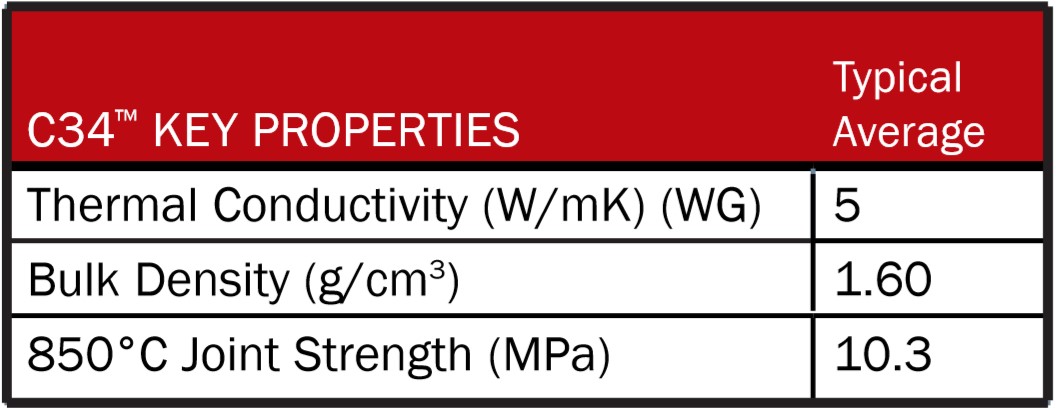DESCRIPTION
C34™ Cement is a two part carbonaceous heat setting cement specifically for use as a mortar between carbon or graphite structural shapes. C34™ Cement is used extensively in blast furnaces, cupolas, ferroalloy furnaces, phosphorus furnaces, runout troughs and other metallurgical applications. It thermally cures to form a strong carbonaceous bond between the cemented shapes. This extraordinary cement will cure at temperatures as low as 60°C, with maximum strength obtained with curing temperatures exceeding 100°C over 24 hours. Even more uniquely, specified flexural strength has proven to be obtained even with a delay of up to 12 weeks between mixing/application and curing.
This product is not designed for and should not be used as a working coating on hot face of furnace lining.
This product can also be formulated as a grout to be pumped into a hot operating furnace which has been temporarily shut down for repairs, to re-establish cooling contact between furnace refractories, shell, and other cooling members. The instructions for use of C-34 Cement as a grout, are identical to those for use of UCAR® GR-37 Grout. Please request and use the GR-37 grout instructions for the proper and safe procedures for handling, mixing, pumping, and use of C-34 as a grout.
 PACKAGING
PACKAGING
The ingredients for the preparation of C-34 Cement are supplied in individual containers labeled to show contents and assembled in standard 4.5 Kg (10-pound), 15.9 Kg (35-pound), and 79.4 Kg (175pound) package units.
STORAGE
The unmixed ingredients for UCAR Grade C-34 Cement will not deteriorate if kept covered and stored in a cool, dry place.
PREPARATION FOR USE
Standard packaging of the 4.5 Kg and 15.9 Kg (10 and 35 pound) units provides for one container of liquid to be mixed with one companion drum of powder. For 79.4 Kg (175 pound) units, mix one 21.3 Kg (47 pound) container of liquid with two 29.1 Kg (64 pound) boxes of powder. If a smaller quantity is desired, use the following proportions: 100 parts by weight of powder to 35.3 parts by weight of liquid. The liquid should be thoroughly stirred before removing from the container.
Excessive thinning of the cement with the liquid component reduces the strength of the cemented joint. However, due to variations in temperatures, atmospheric conditions, and the sizing of the powder component, it may be necessary to increase or decrease the liquid component by up to 5% maximum to obtain the proper consistency for troweling. The standard recommended cement mixture must be thoroughly mixed before making any decision to change the liquid level.
Cement should be mechanically mixed in a cold mixer. Mixing should continue until a uniform consistency is obtained. Because of the extreme fineness of the dry portion of the cement, agglomerates may be found occasionally in the containers of powder when stored under high humidity conditions or when containers have been punctured. In such cases, the powder should be sifted through a screen about the mesh size of window screen prior to mixing. Once mixed, the cement should be used within a time period that will vary with the temperature as follows:
Temperature Time Period 21°C (70°F) 15 Days 38°C (100°F) 3 Days
Guidelines for mixing one to two 175 pound units of cement. (Total of 2 hours preparation time is required):
1. Completely dump one container of liquid component into paddle type mixer.
2. Add one box of powder component and mix for 15 minutes.
3. Add second box of powder and mix for 30 minutes.
4. Shut off mixer and let sit for 45 minutes.
5. Mix for an additional 30 minutes prior to use. Cement is now ready to use.
6. If mixer is large enough for two 175 pound units then above quantities in steps one thru three can be doubled. Use the same mixing times.
7. A ¾” electric drill with paint type mixing paddle should be available at site when cement is being used if additional mixing of cement is needed.
Cover the cement and store in a cool place (21°C/70°F or less if possible) when not in use. Prior to using, warm the cement to room temperature (approximately 21°C/70°F) but do not overheat. Approximately ½ Kg (1 pound) of cement per square foot of surface is actually required for making joints 1.6mm (1/16 inch) in thickness. To allow for wastage, etc., 0.7 Kg (1½ pounds) per square foot is generally recommended.
COLD WEATHER INSTRUCTIONS
Cements mix better and apply easier when both powder and liquid have been pre-warmed to approximately 38° + 6°C (100° + 10°F). After mixing warmed components, place cement in metal containers and hold at approximately 38°C (100°F) in a water bath.
SURFACE PREPARATION
The surface to be cemented should be clean, dry, and dust free. Nominal metal surfaces should be slightly roughened by sandblasting or other suitable methods. Preferably, the carbon or graphite should not be below 16°C (60°F).
METHOD OF APPLYING
Apply cement to the work with a flat serrated trowel or other suitable tool. Coat both joining surfaces to be cemented, working the cement well into each surface. After both surfaces are coated, add a little cement to the center of one of the coated surfaces to make a "crown." When the surfaces are pressed together, cement will flow from the center to the edges, thereby filling out the joint. Scrape off any excess cement after joint is tightly closed.
Joint thickness of more than 3.2 mm (1/8 inch) should be avoided. If larger voids need to be filled, then the following guidelines are recommended.
Size of Void:
0 mm to 6 mm (0 - 1/4 inch) – Use cement.
6 mm to 11 mm (1/4 - 1/2 inch) – Use 50/50 mixture of cement and graphite ram such as UCAR RP-4, RP-10 or RP-20.
12 mm+ (1/2
≥ inch) - Cut brick such as UCAR® NMA, NMD Grade Carbon or Graphite Brick to fit opening then cement in place.
CURING THE CEMENTED JOINT
The cemented joint should be pre-cured before placing in service. Heat the carbon or graphite to 100°C (212°F) and hold at this temperature for four hours followed by 16 hours at 120-130°C (248266°F) unless the normal application temperature is over 130°C (266°F). Curing temperatures below 100°C (212°F) result in a long set-up time. Too rapid heating causes the cement to extrude from the joint before it sets up. The parts must not be moved after the pre-curing operation is started. With large carbon masses, such as furnace hearths and walls, the heat from the metallurgical process involved will normally cure properly and no pre-cure is required.
With proper pre-curing a strong carbonaceous bond is developed between the carbon or graphite articles cemented. The fabricated structure is then ready for operation at high temperatures which will carbonize the joint and complete the curing.
NOTE: A neutral or reducing atmosphere must be maintained at temperatures above 350° C (662°F).
REMOVING C-34 CEMENT
The liquid component can be used to remove the fresh uncured cement from tools and equipment. Once the cement is cured, it is insoluble in the liquid component. DO NOT use liquid component to clean hands, clothes, or plastics.

















